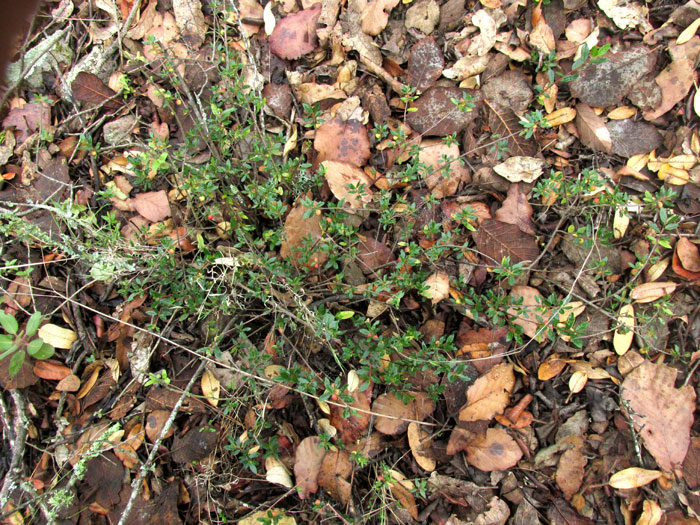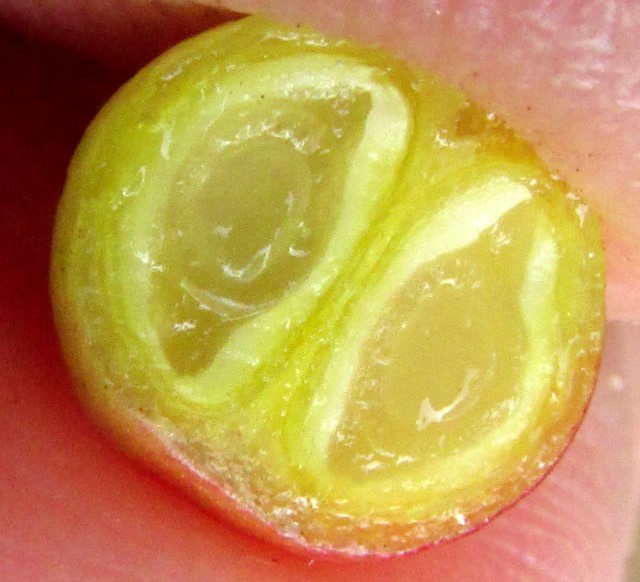Excerpts from Jim Conrad's
Naturalist Newsletter
entry from field notes dated July 2, 2022, taken on the eastern lower slope of Cerro de la Cruz, at an elevation of ~2700m (~8850 ft), just south of the community of El Pinar, Amealco de Bonfil, Querétaro, MÉXICO, (~N20.17°, ~W100.17°)
SNOWBERRY

In a semiopen spot at the edge of the oak forest mantling Cerro de la Cruz's lower eastern slope, the above woody, slender-stemmed, much branched plant sprawled across the forest's carpet of leaves. Barely visible in the photo, it bore a few spherical, green-turning-red, 5mm-wide (1/5inch) fruits:

The leaves were shiny and stiff, most blades bearing 2-5 low teeth along their margins. The plant reminded me of wild Wintergreen of eastern North American forests. Sweet-smelling Wintergreen also is a creeping, semi-shrubby plant with shiny leaves of similar size, plus it produces small, red fruits like the above. Even the fruits of both Wintergreen and this plant hang on short, thick, down-curving stems, or pedicels. Wintergreens don't occur this far south, but Wintergreens are members of the Heath Family, the Ericaceae, and temperate, high-elevation central Mexico is home to its share of that family. Looking for more hints of our plant's identity, I cut across a fruit:

I'd meant to see how many sections, or carpels, the fruit was divided into, by cutting it across the middle. However, with my old-man eyes I couldn't see what I was doing and ended up cutting it lengthwise, from top to bottom. Still, the above picture is interesting. Instead of showing the fruit's five, pie-slice-like carpels, it displays longitudinal sections of two of the five carpels. The two almond-shaped items outlined in white are not the coats of immature seeds, but rather the walls of two of the immature fruit's chambers in which many tiny ovules are maturing into seeds. Especially in the chamber on the left, numerous granular ovules are seen side by side, their bases attached to the surface of the large oval structure occupying the carpel's center.
It turns out that our plant is in fact closely related to North America's Wintergreen. Not only are both plants members of the Heath Family, but also they're both members of the genus Gaultheria. Wintergreen is Gautheria procumbens, and our plant is GAULTHERIA MYRSINOIDES. No English name is associated with our plant, though often Gautheria species are known as snowberries.
Gaultheria myrsinoides is native from northwestern Mexico in Durango state south to northwestern Argentina. In our area it lives in forests of oak, pine and fir, at 2400-3400m in elevation (7850-11,150ft).
The binomial Gaultheria myrsinoides is a fairly new one. Most floras and plant lists in Mexico refer to our plant by a completely different name, Pernettya prostrata, and before that it was Andromeda prostrata, and several other names as well. However, in a 2001 study entitled "An Analysis of the Phylogenetic relationships in the Wintergreen Group (Diplycosia, Gaultheria, Pernettya, Tepuia; Ericaceae)," genetic sequencing by E. Ann Powell and Kathleen A. Kron showed that on the phylogenetic Tree of Life species of the genus Pernettya were nested within the genus Gaultheria. Normally the name of our plant then would have been changed to Gaultherea prostrata, preserving the species part of the binomial, but that name already was taken by a plant in China. Therefore, we have a whole new name, and considerable confusion.
As with Wintergreen, the pulpy fruits of our Gaultheria myrsinoides are relished by wildlife. The fruits themselves are somewhat curious in that technically they are capsule-type fruits, despite capsules being thought of as dry fruits which split in order to release seeds. In fact, our fruit does consist of a capsule, just that it's surrounded by its flower's modified calyx, which enlarged to surround the capsule and became fleshy.
Reportedly humans sometimes eat the fruits, both raw and cooked. I tasted the immature fruit and found it a bit oily-resiny. I'd need to be very hungry to eat many of them.